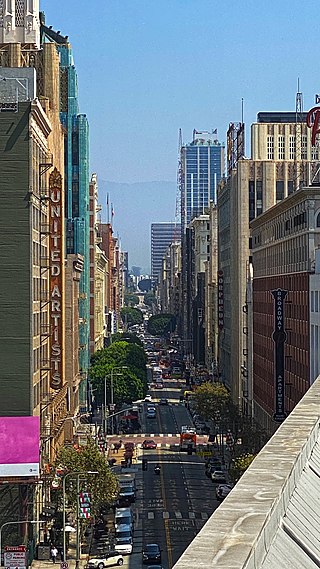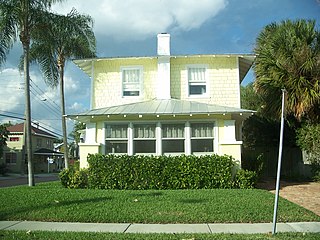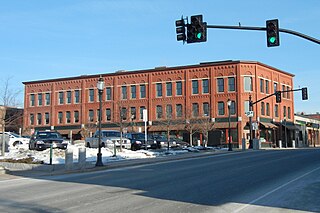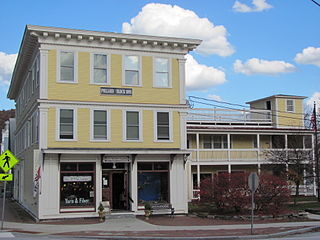
Broadway, until 1890 Fort Street, is a major thoroughfare in Los Angeles County, California, United States. The portion of Broadway from 3rd to 9th streets, in the Historic Core of Downtown Los Angeles, was the city's main commercial street from the 1910s until World War II, and is the location of the Broadway Theater and Commercial District, the first and largest historic theater district listed on the National Register of Historic Places (NRHP). With twelve movie palaces located along a six-block stretch, it is the only large concentration of movie palaces left in the United States.

The Mango Promenade Historic District is a U.S. historic district located in West Palm Beach, Florida. The district is bounded by South Dixie Highway, Austin Lane, Coconut Lane, and Cranesnest Way. It contains 125 historic buildings.

The H.C. Pitney Variety Store Building is a commercial building in downtown Tampico, Illinois, United States, constructed in 1900. The building is part of a two-story commercial block along Main Street.

The La Grange Historic District is a national historic district located in La Grange, North Carolina, United States. The district, originally encompassing 225 buildings and 1 structure, includes the historic commercial, residential, and industrial center of La Grange. The buildings include notable examples of Gothic Revival, Queen Anne and Bungalow/American Craftsman styles of architecture and date between the 1850s and the 1940s. Located in the district is the separately listed La Grange Presbyterian Church. Other notable buildings include the Sutton-Kinsey House, Walter Pace House, Sutton-Fields House, Colonel A. C. Davis House (1887), and the Rouse Banking Company Building (1908). The historic district was added to the National Register of Historic Places in May 2000.

The Masonic Block is an historic commercial block in Reading, Massachusetts. This three-story brick building is distinctive in the town for its Renaissance Revival styling. It was built in 1894 by the local Reading Masonic Temple Corporation, and housed the local Masonic lodge on the third floor. The building was listed on the National Register of Historic Places in 1984.

The Monroe Avenue Commercial Buildings, also known as the Monroe Block, is a historic district located along a block-and-a-half stretch at 16-118 Monroe Avenue in Detroit, Michigan, just off Woodward Avenue at the northern end of Campus Martius. The district was designated a Michigan State Historic Site in 1974 and listed on the National Register of Historic Places in 1975. The thirteen original buildings were built between 1852 and 1911 and ranged from two to five stories in height. The National Theatre, built in 1911, was the oldest surviving theatre in Detroit, a part of the city's original theatre district of the late 19th century, and the sole surviving structure from the original Monroe Avenue Commercial Buildings historic period.

The Randolph Street Commercial Buildings Historic District is a historic district located in Downtown Detroit, Michigan, which includes six buildings along Randolph Street between Monroe and Macomb streets. The district was listed on the National Register of Historic Places in 1980. The collection of buildings are a rare surviving set of Detroit Victorian-era commercial structures. The Randolph Street Commercial Building Historic District joins the Broadway Avenue Historic District downtown.

The Abrams Building was located at South Pearl Street and Hudson Avenue in Albany, New York, United States. It was a brick commercial building constructed in the 1880s. In 1980 it was listed on the National Register of Historic Places.

The Lake Linden Historic District is located in the village of Lake Linden in Houghton County, Michigan.
Wilfred E. Mansur (1855–1921) was the most prominent architect in late 19th and early 20th century Bangor, Maine.

The Barber Block is a building complex located at the corner of Southeast Grand and Washington Streets in Portland, Oregon, listed on the National Register of Historic Places (NRHP). It was built in 1890 and listed on the NRHP in 1977. It is also located within the East Portland Grand Avenue Historic District.
Harvey and Clarke was an American architectural firm formed by Henry Stephen Harvey and L. Philips Clarke in West Palm Beach, Florida, in 1921. The firm was active in South Florida for only a few years, but in that time designed a number of distinctive homes, apartments, churches, and commercial buildings. Harvey was a member of the West Palm Beach Planning Commission. An additional Firm member and staff was Gustav Maass, who designed several local railroad stations, and later became a noted South Florida architect in his own right.

The Libby-Hill Block is a historic commercial building at 227-233 Water Street in downtown Augusta, Maine. Built in 1866 by two prominent businessmen after a fire destroyed part of the downtown, it is one of the city's oldest granite commercial buildings. It was listed on the National Register of Historic Places in 1986.

The Pollard Block is a historic commercial building at 7 Depot Street in Cavendish, Vermont. Built in 1895, it is a fine local example of commercial Italianate architecture, and was home to the village general store for 70 years. It was listed on the National Register of Historic Places in 2008.

The La Crosse Commercial Historic District is located in downtown La Crosse, Wisconsin. It includes over ninety contributing structures, mostly 2-3 story commercial brick buildings constructed from the 1860s to the 1940s. The district is roughly bounded by Jay Street, Second Street South, State Street, and Fifth Avenue South.

The New Center Commercial Historic District is a commercial historic district located on Woodward Avenue between Baltimore Street and Grand Boulevard in Detroit, Michigan. It was listed on the National Register of Historic Places in 2016.

The Mayo Building is a historic commercial building at Main and East Streets in downtown Northfield, Vermont. Built in 1902, it is a prominent and imposing example of Classical Revival architecture. It was listed on the National Register of Historic Places in 1983.

The Western Union Building, formerly known as the Hagerty Block and currently as the Dacotah Prairie Museum, is a historic bank building in Aberdeen, South Dakota. It is individually listed on the National Register of Historic Places and is a contributing property to the Aberdeen Commercial Historic District.

The Royal Poinciana Way Historic District is a historic commerce and residential district in Palm Beach, Florida. The district is bounded by the area from 207-283 Royal Poinciana Way, 95-118 North County Road, and 184-280 Sunset Avenue, with some exceptions. There are 36 buildings within the district, 26 of which are considered contributing properties. The Royal Poinciana Way Historic District became a listing in the National Register of Historic Places (NRHP) on September 17, 2015. A post office located at 95 North County Road has also been listed in the NRHP since 1983. Further, the town of Palm Beach considers the post office, Bradley House Hotel, and the Biltmore Apartments as town landmarks.





















